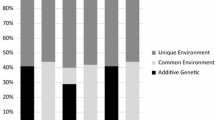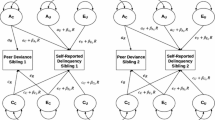Abstract
Adolescent twins reported delinquent acts on an anonymous questionaire. Intraclass correlations and mean squares were obtained by analysis of variance. Monozygotic (MZ) twins were more alike in their rates of antisocial behavior (ABS) than dizygotic (DZ) twins, and this result held for both sexes (rs MZ, 0.62–0.74; rs DZ, 0.46–0.52). Biometrical models were fitted to ASB (untransformed and log-transformed) mean squares. Only models containing a parameter for additive genetic variability fitted; the purely environmental common environment (CE) specific environment (SE) model was rejected. Several tests supported the equal environments assumption, indicating that the inference of genetic influence was legitimate. However, antisocial behavior was a complex “phenotype.” A correlation between pair means/differences showed that influences common to twin partners interacted with SE. This result suggested that random evironmental opportunities which may be present for one twin but not the other had an effect on delinquency rates. Twins also commited delinquent acts with one another. This result provides a different interpretation for the “common-environment” parameter; this parameter may reflect the influence of one twin on the other, rather than aspects of home environment determined by the twins' parents.
Similar content being viewed by others
References
Christiansen, K. O. (1970). Crime in a Danish twin population.Acta Genet. Med. Gemellol. 19:232–236.
Cloninger, C. R., Christiansen, K. O., Reich, T., and Gottesman, I. I. (1978). Implications of sex differences in the prevalences of antisocial personality, alcoholism, and criminality for familial transmission.Arch. Gen. Psychiat. 35:941–951.
Dalgard, O. S., and Kringlen, E. (1976). A Norwegian twin study of criminality.Br. J. Criminol. 16:213–232.
Fuller, J. L., and Thompson, W. R. (1978).Foundations of Behavior Genetics, C. V. Mosby, St. Louis.
Gibbons, D. C. (1976).Delinquent Behavior, Prentice-Hall, Englewood Cliffs, N.J.
Gold, M. (1970).Delinquent Behavior in an American City, Brooks-Coles, Belmont, Calif.
Gold, M., and Petronio, R. J. (1980). Dennquent behavior in adolescence. In Adelson, J. (ed.),Handbook of Adolescence, John Wiley, New York.
Hirschi, T., and Hindelang, M. J. (1977). Intelligence and delinquency: A revisionist review.Am. Sociol. Rev. 42:571–587.
Jinks, L. J., and Fulker, D. W. (1970). Comparison of the biometrical genetical, MAVA, and classical approaches to the analysis of human behavior.Psychol. Bull. 73:311–349.
Loehlin, J. C., and Nichols, R. C. (1976).Heredity, Environment, and Personality, University of Texas Press, Austin.
Lykken, D. T., Tellegen, A., and DeRubeis, R. (1978). Volunteer bias in twin research: The rule of Two-thirds.Soc. Biol. 25:1–9.
Nichols, R. C., and Bilbro, W. C. (1966). The diagnosis of twin zygosity.Acta Genet. 16:265–275.
Rosenthal, R., and Rosnow, R. L. (1975).The Volunteer Subject, Wiley Interscience, New York.
Rowe, D. (1981). Environmental and genetic influences on dimensions of perceived parenting: A twin study.Dev. Psychol. 17:203–208.
Rowe, D. C., and Plomin, R. (1981). The importance of nonshared (E1) environmental influences in behavioral development.Dev. Psychol. 17:517–531.
Scarr, S., and Carter-Saltzman, L. (1979). Twin method: Defense of a critical assumption.Behav. Genet. 9:527–542.
Tittle, C. R., Villemez, W. J., and Smith, D. A. (1978). The myth of social class and criminality: An empirical assessment of the emprical evidence.Am. Sociol. Rev. 43:643–656.
Author information
Authors and Affiliations
Additional information
This research was supported by Grant MH34086 from the Alcohol, Drug Abuse and Mental Health Administration of the Department of Health and Human Services. I wish to express my thanks to the twin respondents, Mothers of Twins Clubs, and Ohio School Districts for their generous cooperation with this study. The assistance of Nancy Winship-Cook with data entry and administration is gratefully acknowledged.
Rights and permissions
About this article
Cite this article
Rowe, D.C. Biometrical genetic models of self-reported delinquent behavior: A twin study. Behav Genet 13, 473–489 (1983). https://doi.org/10.1007/BF01065923
Received:
Accepted:
Issue Date:
DOI: https://doi.org/10.1007/BF01065923




